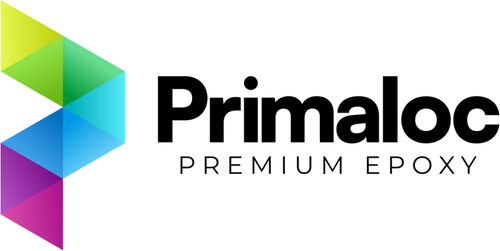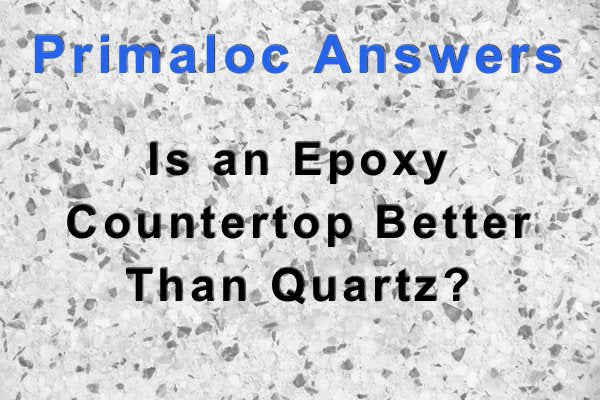Epoxy and quartz are both popular materials for countertops, highly valued for their sheer physical strength, their resistance to stains, and their resilience against different types of chemicals. These two materials offer a similar range of benefits but exhibit distinct differences in their vulnerabilities.
In this Primaloc Answers guide, we'll be comparing epoxy and quartz to each other, focusing on the strengths they share as well as where they diverge, with the goal to inform you for your next countertop project.
However, before we dive into the comparison, let's first take a look at what these two materials are like.
What Is Epoxy?
Epoxy is a type of liquid polymer that, when cured, transforms into a remarkably sturdy solid. It is typically applied as a finishing coat on a variety of surfaces, capable of turning even flimsier materials like plywood into something robust and beautiful. Epoxy finishes are commonly seen on table tops, countertops, bar tops, and seating, among others.
The application process begins with two distinct liquid components—resin and hardener. Mixing these in precise ratios triggers a chemical reaction, leading the mixture to cure or harden. This transformation usually completes within 72 hours for most projects, though environmental factors like temperature can influence the curing time. It's extremely rare for epoxy not to cure properly unless exposed to very cold conditions.
The strength and quality of epoxy can vary significantly. High-grade epoxy resins boast strength surpassing some metals, while lower-quality ones might be brittle and less reliable.
Our Primaloc Bar & Table Top Epoxy is produced using top-notch ingredients to enhance its durability and resistance to frequent use and unexpected impacts.

What Is Quartz?
Engineered stone quartz is a countertop material crafted from a blend of highly pure ground quartz mineral and a binding resin, typically epoxy or polyester.
The creation of an engineered stone quartz slab involves placing the quartz-resin mix into a mold and applying a process known as vibrocompression vacuuming. This method employs intense vibration and pressure to compact the mixture into a dense, uniform slab. The vibratory action helps expel air, ensuring the resin thoroughly saturates the ground quartz.
Note: It's important to distinguish between quartz and quartzite. Quartz refers to the mineral used in engineered stone, whereas quartzite is a naturally occurring rock, predominantly (but not entirely) composed of quartz mineral, which can be mined and cut into slabs for various applications. Unlike engineered quartz, quartzite slabs are extracted directly from quarries and processed for use in construction and design.
Is an Epoxy Countertop Better Than Quartz?
Next, we'll explore the differences between epoxy and quartz across several key aspects to understand how they stack up against each other.
Our comparison will include:
- Physical Resistance: We'll assess their resistance to scratches and impacts, determining which material offers greater resilience.
- Stain Resistance: By examining each material's resistance to chemicals and water, along with their porosity, we can gauge their vulnerability to staining.
- Heat Resistance: We'll compare how well each material can withstand heat, which is crucial for kitchen countertop applications.
- Aesthetic Appeal: The visual appeal and clarity of each material will be considered, noting how pristine and visually striking they appear.
- Maintenance Needs: We'll delve into the upkeep each material demands, comparing the frequency and intensity of cleaning and maintenance needed to preserve their condition and appearance.
Factor #1: Physical Resistance
When it comes to durability and physical resilience, both epoxy and quartz are superb. Either material is a formidable option for use in high-traffic environments exposed to constant wear and tear or rough use, with many users finding little to no damage even several years later.
However, in the event that either material is damaged, it's far easier to mend an epoxy finish than it is to fix an engineered quartz countertop.
That said, damage to these materials is rare and both are exceptional choices for countertop substrates.
Factor #2: Stain Resistance
Both epoxy and quartz are also highly stain resistant. Both materials are very smooth at a microscopic level, preventing liquids and residues from permeating the exterior and leaving behind stains or blemishes.
This is a common reason for why epoxy is valued as a finish in general. Thanks to its waterproof surface, it protects any substrate material from staining, water damage, and rot.
Factor #3: Heat Resistance
When it comes to heat resistance, both epoxy and quartz offer suitable levels of tolerance for everyday use. The binding resins in quartz countertops, as well as the resin in epoxy surfaces, can typically handle up to 135°F without issues.
However, when exposed to temperatures above 135°F, epoxy might start to soften or show signs of heat damage. On the other hand, the quartz particles in engineered quartz countertops are quite heat resistant, but the resin binder that keeps the crusheed quartz together, could potentially soften or degrade under extreme heat. This scenario is most relevant in kitchen settings where hot items are commonly placed on surfaces.
To safeguard both epoxy and quartz countertops from potential heat damage, it's advisable to use protective barriers such as trivets or pot holders when placing hot items on the surfaces, ensuring longevity and maintaining a clean, pristine appearance.
Factor #4: Aesthetic Appeal
High-quality epoxy resin is renowned for its ability to cure to a perfectly clear finish, effectively highlighting the beauty of the underlying material it covers. It also offers a unique advantage in that users can add a variety of colorful pigments to the resin, achieving an opaque look and creating numerous visual effects, such as mimicking the look of marble.
Quartz, valued for its aesthetic appeal, naturally occurs in various colors, though its range is somewhat limited compared to the customization options of epoxy. The inherent clarity of quartz can be altered by the presence of other mineral impurities, which are often desired as they produce different hues and add to its visual appeal.
In the manufacturing of quartz countertops, these natural or added impurities contribute to each slab's unique appearance. While quartz offers a more natural look, epoxy stands out for its versatility in design, allowing for a broader spectrum of styles and effects that can be tailored to individual preferences.
At the end of the day, both materials are celebrated for their beauty, but epoxy provides an unparalleled level of customization.

Factor #5: Maintenance Needs
Maintaining an epoxy finish or a engineered stone quartz countertop is relatively simple and can be accomplished with common household cleaners, as well as just soap and warm water. Glass cleaners and multi-surface cleaners are both viable options for cleaning off residues, liquids, and other substances from a quartz or epoxy surface.
Unlike other sealants, epoxy resin also does not require regular reapplication as part of a maintenance routine. It requires minimal upkeep, and most users won't need to refresh their finish for 7 years or more.
Learn more about epoxy cleaning and maintenance in our FAQs article about the topic.
Though Both Materials Are Exceptional, Epoxy Costs Less.
Ultimately, both epoxy and quartz stand out as excellent materials for countertops, each with its own set of advantages. Epoxy offers a more budget-friendly option, especially when you consider its versatility and the potential for personalization. It allows for a broader range of design choices and can be applied over various substrates, including less expensive ones, providing a cost-effective yet attractive finish.
Our premium Primaloc Bar & Table Top Epoxy is user-friendly and suitable for DIY enthusiasts, although engaging someone with experience is advisable for the initial application in a countertop project is often recommended to guarantee ideal results. Nevertheless, the maintenance or renewal of epoxy countertops down the line is straightforward, enabling homeowners to refresh their surfaces with ease.
In contrast, quartz typically comes with a higher upfront cost due to material and installation expenses, in turn providing a different value proposition through its natural aesthetics.
Epoxy, on the other hand, not only serves as an economical alternative but also offers the flexibility to be used on a variety of surfaces, including existing quartz countertops, enhancing their appearance and functionality.
Primaloc Epoxy: Premium Epoxy for Premium Results
When it comes to epoxy resin, Primaloc Epoxy gets the job done. Our epoxy resin is premium-grade, with high performance in every category, including:
- Unmatched Strength: A Primaloc finish won't buckle, even under high pressure.
- Long-Lasting Resilience: Primaloc epoxy lasts for many years with minimal care, and can endure high-traffic environments with ease.
- A Crystal-Clear Coating: With its pristine, transparent appearance, looking at a cured Primaloc coating is like peering through a window.
Epoxy resin can be beautiful, strong, and long-lasting—which is why you shouldn't compromise on quality. With Primaloc Epoxy Resin, you get the ultimate finish in durability and visual appeal.
Protect your surfaces by giving them a rock-solid epoxy finish. Choose strong. Choose reliable. Choose Primaloc.




